THE SECOND INCUNABLE PRINTING OFFICE IN HUNGARY
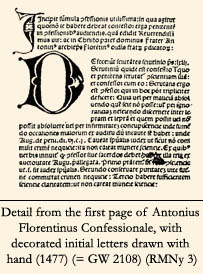 The existence of a second printing shop besides that of Andreas Hess in Buda remained unknown for centuries. It was only in 1958 that investigations in the history of printing and incunabula provided definite proofs for its activity between 1477 and 1480. Neither the owner or printer, nor the place of activity of this second Hungarian printing office is known as yet, as it remained in obscurity for almost 500 years. This is why both Hungarian and international literature refer to it - taken from the title of one of its products - as the printing office of the Confessionale.
The existence of a second printing shop besides that of Andreas Hess in Buda remained unknown for centuries. It was only in 1958 that investigations in the history of printing and incunabula provided definite proofs for its activity between 1477 and 1480. Neither the owner or printer, nor the place of activity of this second Hungarian printing office is known as yet, as it remained in obscurity for almost 500 years. This is why both Hungarian and international literature refer to it - taken from the title of one of its products - as the printing office of the Confessionale.

THE PRODUCTS OF THE CONFESSONALE OFFICE
Based on the identity of its printing types three prints could be determined as the publications of this so-far unknown incunable office working in Hungary: the Confessionale by ANTONIUS Florentinus dated to 1477, (after which the this printing office was named), further, an edition of Laudivius De vita beati Hyeranimi about the life of St. Hieronymus without imprint and a single-leaf printed formula of indulgence with hand-written dating from "Posonium" 11th May 1480 and signed by Johannes Han.
|
|
The closing lines of Confessionale reveal only the year of printing (1477) |
Johannes Han dated and signed the printed letter of indulgence in Pozsony (Pressburg, Bratislava, SK) in 1480 (courtesy of Archiv hlavneho mesta SR Bratislavy, Oddelenie Knižničkých fondov, Bratislava, SK) (RMNy 6) |
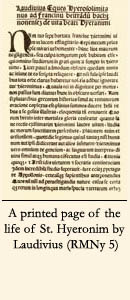 Neither of these three works representing the products of this office has a full imprint, it is only the Confessionale which bears an imprint date.
Neither of these three works representing the products of this office has a full imprint, it is only the Confessionale which bears an imprint date.
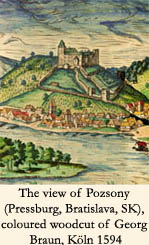 On the basis of its date the single sheet political pamphlet issued by King Matthias Corvinus against Emperor Friedrich III in 1477 was very likely the product of the same incunable press, although there is no surviving copy of it that could positively prove the assumption.
On the basis of its date the single sheet political pamphlet issued by King Matthias Corvinus against Emperor Friedrich III in 1477 was very likely the product of the same incunable press, although there is no surviving copy of it that could positively prove the assumption.
The three prints of this unknown Confessionale office are extant in altogehter seven copies, each of them surviving from the territory of historical Hungary reasoning for its Hungarian location.

THE PLACE OF THE CONFESSIONALE OFFICE: BUDA OR POZSONY/PRESSBURG?
Tracing back the site of the second Hungarian pritning office it is especially the indulgence letter issued by Han, parson of the St. Martin Cathedral in Pressburg for a local person, Agnes de Posonio that suggests that the press was located in Pressburg, in upper Hungary. However, these formulas could be filled anywhere, not only at the place they were printed.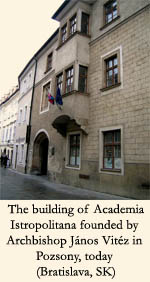 To set up a press in a town where a university is established seems to be acceptable argument, however, the Academia Istropolitana in Pressburg founded by Cardinal János Vitéz, Archbishop of Esztergom, ceased soon after the founder's death. There is no trace of its activity from 1474 onwards, i.e. from the time of the Confessionale office - if it was in fact working in Pressburg.
To set up a press in a town where a university is established seems to be acceptable argument, however, the Academia Istropolitana in Pressburg founded by Cardinal János Vitéz, Archbishop of Esztergom, ceased soon after the founder's death. There is no trace of its activity from 1474 onwards, i.e. from the time of the Confessionale office - if it was in fact working in Pressburg. 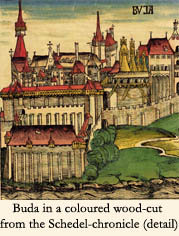 There are several reasons that make the printing place Buda more likely. The queen of King Mathias Corvinus Beatrix of Aragone has just arrived to Hungary in 1476, the year preceding the first product of this unknown incunable press. The connection of the Neapolitan Aragone-dinasty with printers of Naples is well-known, and in this respect the relationship of the printing types of the Confessionale office with those of the Neapolitan Moravus office may also serve as an argument. Thus, this printing office active between 1477-1480 may have settled in the royal seat Buda and might have been associated with the royal court, even if the first efforts by Andreas Hess to establish printing in Buda were short-lived. Although we have no knowledg of the possible patron of this printing office, some sort of connection with the royal court in Buda cannot be excluded. Moreover, as to the contents of at least one of its products, the Confessionale , it author was a significant dominican friar and Buda was at the time one of the larges Dominican centres in Europe.
There are several reasons that make the printing place Buda more likely. The queen of King Mathias Corvinus Beatrix of Aragone has just arrived to Hungary in 1476, the year preceding the first product of this unknown incunable press. The connection of the Neapolitan Aragone-dinasty with printers of Naples is well-known, and in this respect the relationship of the printing types of the Confessionale office with those of the Neapolitan Moravus office may also serve as an argument. Thus, this printing office active between 1477-1480 may have settled in the royal seat Buda and might have been associated with the royal court, even if the first efforts by Andreas Hess to establish printing in Buda were short-lived. Although we have no knowledg of the possible patron of this printing office, some sort of connection with the royal court in Buda cannot be excluded. Moreover, as to the contents of at least one of its products, the Confessionale , it author was a significant dominican friar and Buda was at the time one of the larges Dominican centres in Europe.
THE PRINTING TYPES AND PAPER OF THE PRESS
Unlike Hess' printing shop which had only one renaissance roman type, the Confessionale office was equipped with at least four fraktur types of different scales. The types suggest a relationship with the Moravus-office in Naples, the printer with his cast types may have come from there.
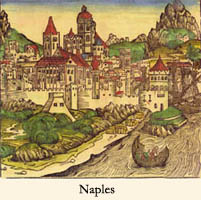 The papers of the three products of the Confessionale office bear two types of watermarks: one with a bull-head and the other with different variations of scales.
The papers of the three products of the Confessionale office bear two types of watermarks: one with a bull-head and the other with different variations of scales.
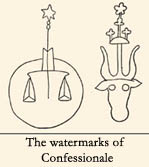 Although similar, the latter are not identical with those used in Hess' workshop, the other Hungarian printing shop producing incunables.
Although similar, the latter are not identical with those used in Hess' workshop, the other Hungarian printing shop producing incunables.

PRINTING TYPES
<<back to the top <<

LITERATURE:
Régi Magyarországi Nyomtatványok 1. Írta Borsa Gedeon, Hervay Ferenc, Holl Béla, Käfer István. Budapest 1971 (rövidítése: RMNy)
Soltész Zoltánné: A második magyarországi ősnyomda nyomai. In: MKsz 1958. 144-157. - Soltész, Elisabeth: Ein Unikum-Inkunabel der Budapester Universitätsbibliothek. Ein neues Dokument für das Wirken einer unbekannten ungarländischen Druckerei im 15. Jahrhundert. In: Gutenberg Jahrbuch 1958. 59-68 - A Confessionale-nyomda betűiről: V. Ecsedy Judit: A régi magyarországi nyomdák betűi és díszei 1473-1600. Bp. 2004. 42-44,209-210. - Csapodi Csaba: Wo war die zweite ungarische Inkunabeldruckerei tätig? (Buda oder Pozsony/Pressburg)? In: Gutenberg Jahrbuch 1983. 163-165.
Schedel, Hartmann: Weltchronik. Nürnberg 1493, Koberger
Gesamtkatalog der Wiegendrucke I-VIII/1. Berlin 1925-1940 (rövidítve: GW)
Laudivius eques Hyerosolimitanus ad Francinum Beltrandum Bachinonensem de vita beati Hyeronimi. Hasonmás kiadás, Bp. 1975